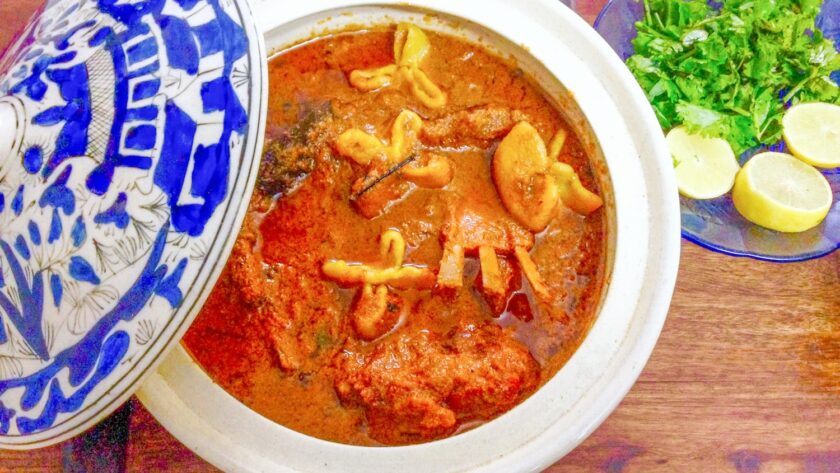By Masha Hassan, Guest Contributor
There’s been speculation in New Delhi, India that one of the ministers wants to ban momos (dumplings) in the city.
Delhites’ obsession with this street snack has led to memes, jokes and status updates about the terror of a city without dumblings; but, don’t worry — there is an alternative. Though time-consuming, akhti, a traditional Mughlai dish of beef stew dumplings, will surely satisfy any momo cravings.
When I was a child my grandmother would pull her sari up to her knees and sit on the floor next to a big dekhchi (pot) to chop vegetables and knead dough.
While my cousins were outside playing, I would sit next to her and watch. If I was lucky, she would allow me to punch the dough like a boxing bag.
After three or four hours, my grandmother would open the lid, letting the aroma travel throughout the house. Akhti was a magnet to us — once the lid was open everyone gathered around that hot pot.
On the dastarkhan (spread of food) she would generously ladle out this rich liquid, spooning beautiful golden dumplings and meat pieces in big blue bowls. We were never shy to ask for another helping.
Though akhti is one of the most traditional Mughlai dishes, I’m afraid very few people are familiar with it. The reason seems to be the high-paced life where dinner can often be made out of a can in 10 minutes or less, while preparing akhti could be considered a laborious, even herculean, task.

This hearty stew is made in traditional Muslim families, popular mainly in the months of Ramadan. The recipe is passed on from generation to generation. Unlike the popular boeuf a la bourguignon, spezzatino and ragout dishes made with beef, akhti is made from mutton meat.
Dumplings in this recipe are not stuffed with any vegetable or meat. The only ingredients are flour, water, salt and butter. They are cooked in the stew, soaking the dough with flavors. The dumplings give body and personality to the dish, making akhti a complete meal.
There is one thing stews around the world have in common — patience is required during the cooking process. The reward is an aroma of whole spices and succulent, juicy meat that almost falls off the bone.
A Culinary Mission
Unlike biryanis, kebabs and kormas this savory rustic dish won’t be so easy to find in restaurants or street shops to satisfy your palate and curiosity. Akhti evolved in the royal kitchens of the Nawabs of the Mughal Empire in medieval India. The food has strong influences from the region where the Turco Mongol Mughal rulers initially came and now their splendor and style has influenced regional cuisines of Pakistan, Bangladesh and India.
Rediscover akhti, a lost dish of #India with this delicious #recipe! Click To Tweet
The tastes vary from being spicy to mild and the cooking styles are complex, distinctive and luxurious. During the Mughal times every emperor had a Hakim (royal physician) who made sure that there was a use of medicinal herbs and spices like cumin, turmeric, saffron, cilantro and even rose water. Gold and silver pellets were fed to chickens and goats so the medicinal properties could also be passed to the person eating them.
Mughlai dishes have many layers and the eccentricity of this cuisine is seen in their culture. The food is not just about eating — it’s about customs, the eloquence of their language, table mannerisms and, most importantly, the majestic names given to the dishes.
Rather than greasy meals served in restaurants which are now called “Mughlai,” this rich culinary legacy had subtlety and sophistication to it. Sadly the traditional recipes like akhti are dying and, like my childhood flashback, I hope this forgotten dish doesn’t turn into only a memory.
Love #Indian food? Check out this delicious akhti #recipe! Click To Tweet
Akhti Recipe
Ingredients
- 1kg mutton cut into medium sized pieces (thigh portions are best)
- 6 large onions cut into thin slices
- ½ cup curds
- ½ cup mustard oil or clarified butter(ghee)
- 20-25 cloves of garlic
- 20 gms ginger
- 1 ½ tsp garam masala powder
- 2 tsp red chilli powder
- 2 tsp coriander powder
- Salt to taste
- Dry Spices
- 6 bay leaves
- 1 tbsp coriander seeds
- 1 tbsp whole black pepper corns
- 6 large black cardamoms
- 6 green cardamoms
- 3 small cinnamon sticks
- 2 twigs of mace
- 2 pieces of star anise
For The Dumplings
- 2 cups wheat flour or white flour
- 2 tbsp clarified butter(ghee)
- Half tbsp salt
- Water
For Garnishing
- Coriander leaves
- Ginger cut into thin slices
- Lemon juice
Preparation
Make a paste of ginger and garlic.
Wash the mutton pieces. Add 2 tbsp of the ginger garlic paste and 1 tbsp salt. Let it marinate for one to two hours.
Put oil in a frying pan and fry the onion slices until golden brown. Spread the fried onion slices on a napkin to soak the extra oil. This is called “pyaaz biryani” (onion biryani). Crush the onion pieces by hand.
Put oil in a pressure cooker, add all the dry spices and the marinated mutton pieces. Keep stirring.
Take curd in a bowl and beat it. Add red chili powder, coriander powder and salt. Continue beating the mixture until smooth. Add this mixture to the pressure cooker. Add the crushed onion pieces and stir. Let it simmer for some time until the oil starts to separate.
Add four cups of water and pressure cook the mutton until it is tender, but not overcooked.
While the mutton is being cooked, make the dumplings. Sieve flour, add salt, water and ghee. Knead.
Roll small balls of dough and twist them to give a proper shape. Keep the dumplings aside.
Add the dumplings into the stew and let the pot simmer on a slow heat for 10 minutes.
Add the garnish, ginger, coriander leaves and lemon juice. Serve hot.
Enjoy!
References:
A brief history of mughlai food in Agra, India (article; The Culture Trip)
How Agra lost its share of Mughlai food (article; The Daily Mail)
The Emperor’s Table: The Art of Mughal Cuisine (book; Salma Husain)
About The Author
Masha Hassan is a freelance writer and solo female traveler from India. Her byline has appeared in publications like The Times of India, The Economic Times and an Italian newspaper called The Florentine, not to mention online publications like India Travelogue and Tripoto. Hassan mainly writes about spirituality and finding her sacred connection to food and gastronomy.
Jessica Festa
Latest posts by Jessica Festa (see all)
- A Culturally-Immersive Adventure In Mongolia’s Altai Mountains - Jul 8, 2023
- This Recipe Sharing Platform Supports Women In The Culinary Industry (Labneh Recipe Included!) - Nov 5, 2020
- Hiking The Mohare Danda Community Eco-Trek In Nepal - Jun 3, 2020
- 6 Important Questions For Choosing A Responsible Yoga Retreat - May 18, 2020
- How To Create & Grow A Profitable Blogging Business (Ethically) - Jan 18, 2020


![Rediscovering Akhti, A Lost Dish Of India [Recipe Inside]](https://epicureandculture.com/wp-content/uploads/2017/07/Rediscovering-Akhti-A-Lost-Dish-Of-IndiaRecipe-Inside.jpg)





I have lived my whole life in India and you are right, I have no idea about this dish. It is truly lost. I would love to try it out some time. Thanks for unearthing this.
Thank you so much for the lovely recipe. I love it.
Momos is my favorite dish but Akhti looks utterly delicious. Thanks for sharing the recipe.